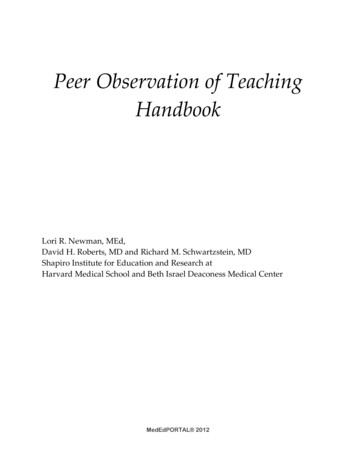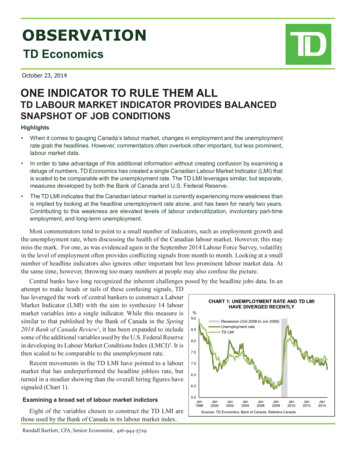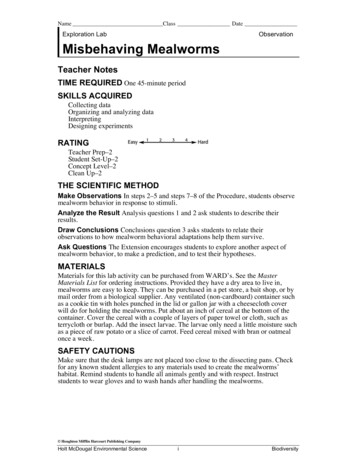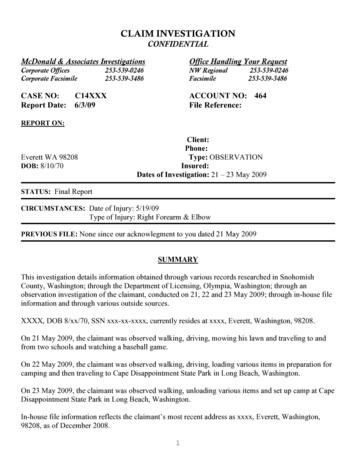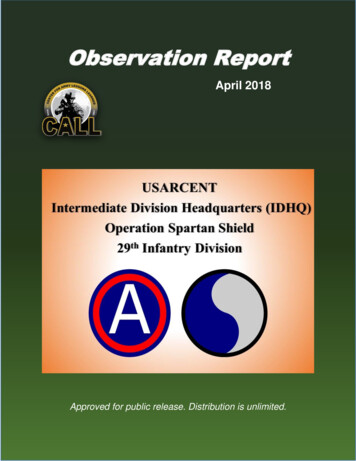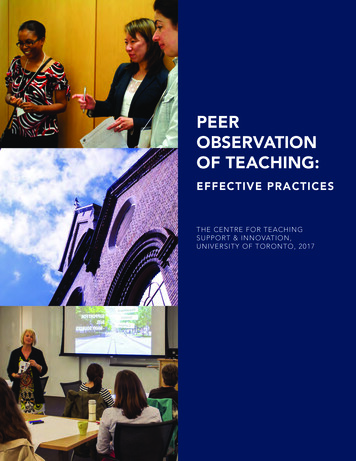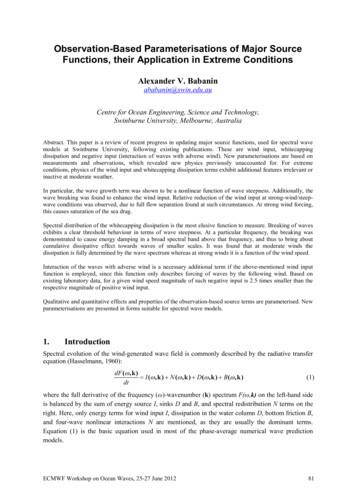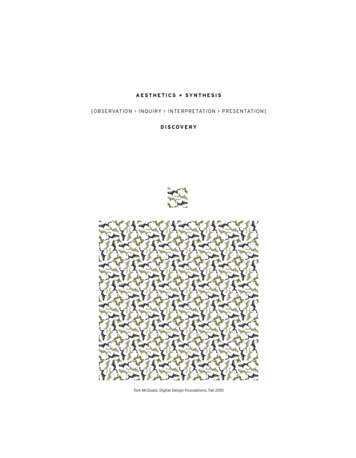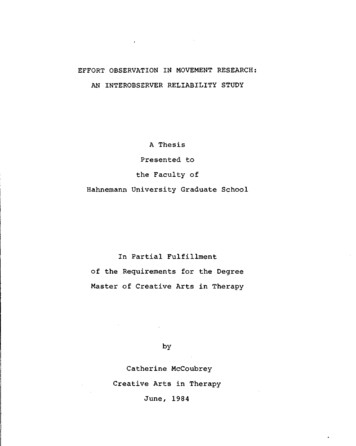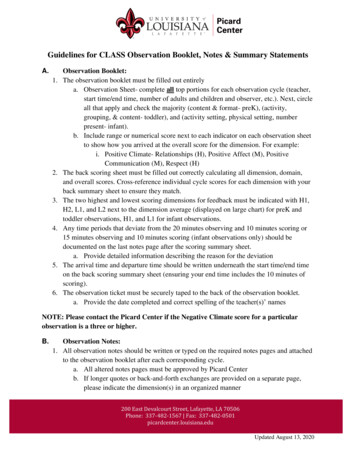
Transcription
Guidelines for CLASS Observation Booklet, Notes & Summary StatementsA.1.2.3.4.5.6.Observation Booklet:The observation booklet must be filled out entirelya. Observation Sheet- complete all top portions for each observation cycle (teacher,start time/end time, number of adults and children and observer, etc.). Next, circleall that apply and check the majority (content & format- preK), (activity,grouping, & content- toddler), and (activity setting, physical setting, numberpresent- infant).b. Include range or numerical score next to each indicator on each observation sheetto show how you arrived at the overall score for the dimension. For example:i. Positive Climate- Relationships (H), Positive Affect (M), PositiveCommunication (M), Respect (H)The back scoring sheet must be filled out correctly calculating all dimension, domain,and overall scores. Cross-reference individual cycle scores for each dimension with yourback summary sheet to ensure they match.The two highest and lowest scoring dimensions for feedback must be indicated with H1,H2, L1, and L2 next to the dimension average (displayed on large chart) for preK andtoddler observations, H1, and L1 for infant observations.Any time periods that deviate from the 20 minutes observing and 10 minutes scoring or15 minutes observing and 10 minutes scoring (infant observations only) should bedocumented on the last notes page after the scoring summary sheet.a. Provide detailed information describing the reason for the deviationThe arrival time and departure time should be written underneath the start time/end timeon the back scoring summary sheet (ensuring your end time includes the 10 minutes ofscoring).The observation ticket must be securely taped to the back of the observation booklet.a. Provide the date completed and correct spelling of the teacher(s)’ namesNOTE: Please contact the Picard Center if the Negative Climate score for a particularobservation is a three or higher.B.Observation Notes:1. All observation notes should be written or typed on the required notes pages and attachedto the observation booklet after each corresponding cycle.a. All altered notes pages must be approved by Picard Centerb. If longer quotes or back-and-forth exchanges are provided on a separate page,please indicate the dimension(s) in an organized manner200 East Devalcourt Street, Lafayette, LA 70506Phone: 337-482-1567 Fax: 337-482-0501picardcenter.louisiana.eduUpdated August 13, 2020
2. All dimension boxes must contain specific evidence to support the dimension scorea. Never leave a dimension box blank3. All indicators must be addressed in notes4. Provide a sufficient number of exact quotes when applicable5. A context or clarification statement should be added to support the numerical scorea. Ex.). Small group activity coloring or matching butterflies; teacher providesactivity but time loss due to preparation or behavioral issues; teacher asked manyhow/why questions but failed to provide adequate wait time for students torespond.C.Guidelines for Selecting Feedback:Highest Scoring Dimensions (PreK and Toddler Observations)1. Once the observation scoring summary sheet is filled out completely, review thedimension score averages and select the highest two averages (indicate which two youhave selected with H1 and H2).2. If you have multiple dimensions with the same average score, select no more than 1dimension in each domain (This only occurs if you have three or more dimensions withthe same average score. If you have only two dimensions with the same score thoseshould be chosen).Example (PreK) - Positive Climate (PC), Teacher Sensitivity (TS) and BehaviorManagement (BM) are all assigned a score of a 7. You would address one dimension inEmotional Support (either PC or TS) and BM in Classroom Organization.Example (Toddler) - Positive Climate (PC), Regard for Child Perspectives (RCP), andFacilitation of Learning and Development (FLD) are all assigned a score of a 6. Youwould address one dimension in Emotional and Behavioral Support (PC or RCP) andFLD in Engaged Support for Learning.2.If more than 1 dimension is assigned the same score in the same domain, use yourjudgment to determine which dimension was most strongly supported by higher-levelbehaviors.3. If all dimensions are scored below a 3, there is no highest scoring dimension to address.NOTE: We are excluding Negative Climate when selecting the highest scoring dimension.200 East Devalcourt Street, Lafayette, LA 70506Phone: 337-482-1567 Fax: 337-482-0501picardcenter.louisiana.eduUpdated August 13, 2020
Lowest Scoring Dimensions (PreK and Toddler Observations)1.Review the dimension score averages and select the lowest two dimension averages(indicate which two you have selected with L1 and L2). If you have multiple dimensionswith the same average score, select no more than 1 dimension in each domain (This onlyoccurs if you have three or more dimensions with the same average score. If you haveonly two dimensions with the same score those should be chosen).Example (PreK)- Instructional Learning Formats (ILF), Quality of Feedback (QF), andLanguage Modeling (LM) are all assigned a score of a 4. You would address onedimension in Instructional Support (QF or LM) and ILF in Classroom Organization.Example (Toddler) - Quality of Feedback (QF), Behavior Guidance (BG), andLanguage Modeling (LM) are all assigned a score of a 3. You would address onedimension in Engaged Support for Learning (either LM or QF) and BG in Emotional andBehavioral Support.2. If more than 1 dimension is assigned the same score in the same domain, use yourjudgment to determine which dimension was most strongly supported by lower levelbehaviors.3. If dimension averages are a 6 or higher, there is no lowest scoring dimension to address.NOTE: Always address Negative Climate in your lowest scoring dimension summary if theaverage score is a 3.5 or higher and notify the Picard Center immediately.Infant Observations:1. You will select the highest and lowest scoring dimension averages. If multipledimensions are assigned the same score, use your judgement to determine whichdimension was supported by higher or lower level behaviors.2. If all dimensions are scored below a 3, there is no highest scoring dimension to address.3. If all dimension averages are a 6 or higher, there is no lowest scoring dimension toaddress.D.Summary Statements (provided for all CLASS dimensions):1. Address each indicator with the following:a. A lead-in statement that addresses the indicator and frequency (past tense)i. Ex). There were many indications that the teachers and students enjoyedwarm, supportive relationships with one another.200 East Devalcourt Street, Lafayette, LA 70506Phone: 337-482-1567 Fax: 337-482-0501picardcenter.louisiana.eduUpdated August 13, 2020
2.3.4.5.b. Specific examples unique to the observationii. Ex). The lead teacher sat on the floor with the students playing with blocksand in a low chair as she worked with students during a sorting game.The number of examples provided must match the frequency term for the indicatora. High-range (many, frequently, always)i. 4 or 5 examplesb. Mid-range (sometimes, occasionally, at times)i. 2 or 3 examplesc. Low-range (rarely, few, does not)i. 1 or no exampleThe specific examples must be written in one of two ways:a. Written in grammatically correct sentences after the lead-in statementi. Ex.). For example, the teacher provided leadership roles for severalstudents during the morning routine including calendar helper, attendancetaker, and weather helper.b. Provided in parentheses and separated by semicolons after the lead-in statementi. Ex. 1). (close proximity sitting on rug with students; shared activities withmatching game; social conversation about weekend plans)ii. Ex. 2). (“Thank you for helping.”; “I appreciate you sharing with yourfriends.”; “I love the way you are being good listeners.”)Choose the strongest examples that support the numerical scoreThe examples should include specific details and/or context when necessarySummary Statement Examples:1. Positive Climate Example: There were many indications that the teachers and studentsenjoyed warm, supportive relationships with one another. The lead teacher sat on thefloor with the students playing with the blocks and in a low chair as she worked with thestudents, picture matching and sorting. Some of the students engaged in peerconversations during centers and whole group and with their teachers abouttoothbrushes, favorite colors, and dinosaurs. There were some displays of positive affectby the teachers and students. During music and movement, the students laughed andwere excited as they imitated animal sounds and movements. They also showedexcitement during the morning routine of attendance. There were many positivecommunications displayed between the teachers and students. The teachers held andpatted students’ hands, hugged students, and some students leaned closely against thesecond teacher. The lead teacher told the students, “You are all great listeners.” and“You are so smart.” The teachers and students often demonstrated respect for one200 East Devalcourt Street, Lafayette, LA 70506Phone: 337-482-1567 Fax: 337-482-0501picardcenter.louisiana.eduUpdated August 13, 2020
another. Both teachers used a calm voice, the students’ names, and eye contact. Thestudents were typically cooperative and shared materials with one another. Respectfullanguage was heard throughout the observation with “please and “thank you.”2. Quality of Feedback Example: The teacher occasionally provided scaffolding throughhints. The teacher pointed to the smart board during the music and movement activityand used physical and verbal assistance to students to help them get the right answer orcomplete an activity (“Follow the block.”; “Hold it and I will help you.”; “Stay withinthe bubble.”). There were occasional back and forth exchanges between the teacher andstudents (parts of the book and holiday celebrations); however, some feedback wasperfunctory where the exchange was brief (“Good answer.”). The teacher rarely queriedthe student or prompted students to explain their thinking or rationale for their responsesor their actions (“Why did you make it pink?”). The teacher inconsistently providedadditional information to expand on the students’ understanding or actions. (Student:“It’ll burn your mouth.” Teacher: “It’s hot. I have to cool it.”; Student: “Theycelebrate.” Teacher: “Families celebrate holidays in different ways.”). The teacheroffered some general praise (“Awesome!”; “Good answer.”; “Good D.”) and somespecific feedback (“Awesome job writing all your numbers.”; “Thank you forrecognizing her name.”).3. Concept Development Example: The teacher rarely used discussions and activities thatencouraged analysis and reasoning. The teacher often asked questions that focused onrecalling facts in a rote manner, rather than asking questions that promoted higher orderthinking skills. For example, she asked questions such as, “What are we going to use tolisten to her?”; “What color would you like?”; “What letter is this?”. On a fewoccasions, the teacher provided opportunities for students to generate their own ideas.For example, the teacher had the students brainstorm about where bugs live and differentaspects of Springtime. On a few occasions, the teacher attempted to link concepts fromone activity to the next, but these connections were brief. For example, the teacherattempted to link the book, Bugs to the outdoor activity but did not take the integrationany further. The teacher rarely attempted to relate concepts to the student’ actual lives.On one occasion, the teacher and students discussed Spring, Easter, and painted eggs butthe discussion only consisted of one or two questions.200 East Devalcourt Street, Lafayette, LA 70506Phone: 337-482-1567 Fax: 337-482-0501picardcenter.louisiana.eduUpdated August 13, 2020
Common Patterns to avoid in Summary Statements:1. Grammatical errors (misspellings, changing tense present/past or vice versa, open quotesor parentheses with missing ending quotes or parentheses), unnecessary spacing and fontchanges.2. The specific examples are vague with no specificity or context.a. For example, the teacher engaged in social conversations with students duringcenter time and whole group.3. The lead-in summary statement contradicts the specific examples provided for eachindicator.a. For example: There were some examples of teachers being aware, responsive, andaddressing problems The teachers were consistently aware of students whoneeded assistance.b. Do not provide a lead-in sentence that addresses all in the indicators together.4. The definition of the dimension is included in the summary statements.5. A closing statement such as “The evidence supports the numerical score of a “6” iswritten at the end of the paragraph.6. Inconsistencies in how specific examples are provided in the summary statements.7. Using frequency terms at the cycle level, as this causes confusion to the reader.Before submitting your feedback into the Early Childhood Portal ensure you havereviewed your writing for the following:1. Double-checked spelling, punctuation, and grammar,2. Spacing and font is uniform throughout my summary statements,3. Each indicator is addressed in summary statements with specific examples and frequencyterminology; and4. The number of examples provided for each indicator MATCHES the frequency termassigned.200 East Devalcourt Street, Lafayette, LA 70506Phone: 337-482-1567 Fax: 337-482-0501picardcenter.louisiana.eduUpdated August 13, 2020
Guidance for Observations & Summary Statements during COVID-19Third-party observers should use Teachstone’s guidance when considering how observationsduring the pandemic may be different from past observations. Please use the followingconsiderations as you prepare for observations during COVID-19: “Some schools are limiting children's interaction with one another by separating them into setsmall groups within the classroom. When this is the case, observers may consider the manual’sguidance related to coding center time at the high range of Concept Development: There shouldbe clear evidence that the teacher is engaging in these types of interactions with students as he orshe moves around the classroom with the assumption that, over time, most students will beexposed to the interactions. (p. 66, Pre-K manual & p. 68, K-3 manual) (Teachstone, 2020, p.5).” “Some behavioral markers may be difficult to assess or simply not present due to new healthand safety procedures (Teachstone, 2020).” “Observers may need to look for evidence of CLASSindicators outside of the behavioral markers listed in the manual. Observers should rememberthat the listed behavioral markers are designed to illustrate the kinds of interactions an observermight see, but are not exhaustive. Additional behavioral markers not listed in the manuals canmeet the overarching intent of both the indicators and dimensions Observers will need to pay close attention to body language and other nonverbalcommunications to determine the intent and efficacy of interactions if the use of masks, socialdistancing, or video recording during observations makes it more difficult to see or hear. In those instances when they cannot hear well, observers should not attempt to interpret whatthe teacher and children are saying. Rather, observers should note, sort, and score based solelyon what they see and hear. Observers should review the section on “Remaining Objective” in Chapter 2 of the manual.Observers must avoid adjusting any scores because a teacher is “doing the best she can” in thecurrent environment. Some observers may be nervous about how their ability to see and hear will be affected byCOVID-related precautions in place in the classroom. Observers should recall that interactionsare multi-faceted. The observer does not capture the fullness of everything communicatedverbally and nonverbally between teachers and children during the observation period for anyCLASS observation, even one conducted under normal circumstances. The observer is limited bythe amount that they can see, hear, and note at once—there is always more happening than canbe captured. All observers have been in classrooms where it is difficult to see or hear certaininteractions due to the classroom layout, the general level of noise when young children are in asmall space, or a particularly soft-spoken teacher. In these cases, observers must focus on whatthey can see and hear, which is typically sufficient to assess all CLASS dimensions UpdatedAugust 31, 2020 - Page 14 (Teachstone, 2020).”200 East Devalcourt Street, Lafayette, LA 70506Phone: 337-482-1567 Fax: 337-482-0501picardcenter.louisiana.eduUpdated August 13, 2020
Infant ObservationsPlease refer to Teachstone’s guidance on recognizing behaviors during COVID-19. Found m%20Covid19Impacts InSchool Infant.pdfToddler ObservationsPlease refer to Teachstone’s guidance on recognizing behaviors during COVID-19. Found %20Covid19Impacts InSchool Toddler.pdfPreK ObservationsPlease refer to Teachstone’s guidance on recognizing behaviors during COVID-19. Found %20Covid19Impacts InSchool PK-K3.pdfSummary Statement Guidance:The summary statement template can still be used to write your summary statements for yourobservations. Most of the summary statements are still applicable; however, clarificationstatements might be needed with slight changes in the behaviors observed following thesummary statements.Please see the following examples Infant Observations- Relational Climate:Relational Behaviors- All summary statements are still applicable. Physical proximity, eyecontact, joint attention, and verbal and physical affection should be observable, with teachersmaking only slight adjustments to these behaviors. Your examples might change following yoursummary statements such as the infant sat close or next to the teacher rather than in her lap.Emotional Expression- All summary statements are still applicable. The high range statementcould be modified if the teacher is wearing a mask or face covering where smiles are notobserved. However, you may still use the statement if you see the following: teachers’ smiling isevident in their eyes, eyebrows, temples, and cheekbones or the teacher uses photos to expresspositive emotions.Respect for Infants’ State- All summary statements are still applicable. Observers should lookfor teachers to clearly communicate their intentions when they need to remove a toy or wash aninfant’s hands.Lack of Adult Negativity- All summary statements are still applicable. Overall, behavioralmarkers within this indicator remain unaffected. However, with increased concerns aroundcoughing and sneezing, it is important for teachers to monitor and mitigate their own negative200 East Devalcourt Street, Lafayette, LA 70506Phone: 337-482-1567 Fax: 337-482-0501picardcenter.louisiana.eduUpdated August 13, 2020
feelings when they come into contact with infants’ saliva. Observers will look for teachers toremain positive in their interactions when infants sneeze, cough, or drool.200 East Devalcourt Street, Lafayette, LA 70506Phone: 337-482-1567 Fax: 337-482-0501picardcenter.louisiana.eduUpdated August 13, 2020
Aug 13, 2020 · Summary Statement Examples: 1. Positive Climate Example: There were many indications that the teachers and students enjoyed warm, supportive relationships with one another. The lead teacher sat on the floor with the students playing with the blocks and in a low chair as sh


